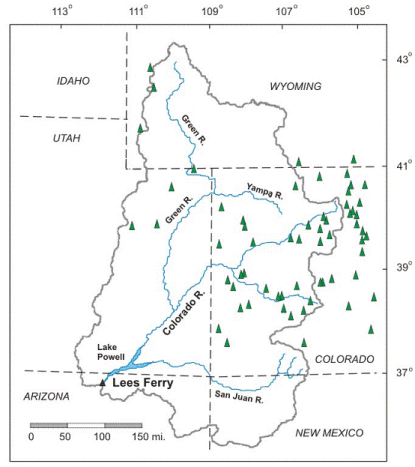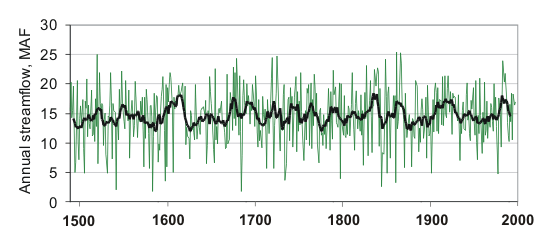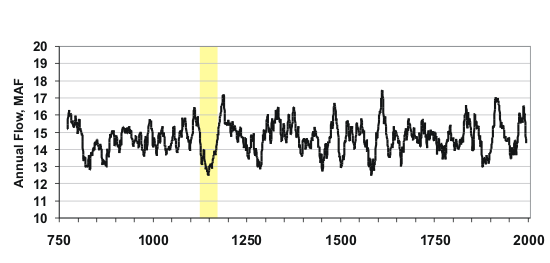The latest reconstructions (2006 - 2007)
Through the 1990s, streamflow reconstructions in the Colorado River basin had been limited by the tree-ring data available, much of which was collected in the 1960s and 1970s. In 2000, a concerted effort to update the old tree-ring chronologies and sample new sites was undertaken by Connie Woodhouse and colleagues at the National Climatic Data Center's Paleoclimatology Branch and the University of Colorado's Institute of Arctic and Alpine Research. By 2004, they had developed some 60 chronologies in Colorado, Utah, New Mexico, and Wyoming, within the upper Colorado River basin and adjacent basins. During this period, Stephen Gray of the University of Wyoming had also developed several new chronologies in northeastern Utah and southwestern Wyoming. (See the map below for locations of these chronologies.)
In the meantime, the mostly wet conditions in the Colorado River Basin in the 1990s had given way to drought that began in late 1999. Natural flows at Lees Ferry in 2000 and 2001 were only 74% and 73% of the long-term average, respectively. Then the drought worsened markedly in 2002, with 41% of the average flow, the second-worst year on record after 1977. The drought continued in 2003 and 2004, with flows at Lees Ferry still well below average. With lower basin demand exceeding inflows for five straight years, Lake Powell dropped to only 33% of capacity in April 2005. The drought raised concerns for the sustainability of water supplies in the basin, and revived interest in the longer-term perspective on streamflow variability provided by tree rings.

< /br>
< /br>
Woodhouse et al. (2006)
In 2005, Woodhouse, Gray, and David Meko of the University of Arizona's Laboratory of Tree-Ring Research (LTRR) used the network of new tree-ring chronologies to generate updated reconstructions of streamflow for the Colorado River. They reconstructed the natural flows at 10 gages in the basin, including Lees Ferry. Recognizing the sensitivity of the final output to modeling choices, they generated multiple reconstructions for each gage using different techniques to process and calibrate the tree-ring data. The four reconstructions generated for Lees Ferry were all quite similar, demonstrating the robustness of the reconstruction result. The reconstruction below ("Lees-A') was one of the more conservative models.

The Woodhouse et al. reconstruction confirmed some of the major findings from the previous reconstructions: that the early 1900s was anomalously wet relative to the preceding centuries, and there were numerous droughts more sustained and/or severe than those of the 20th century. The reconstructed long-term average annual flow was 14.7 MAF/year (for the Lees-A model), which is higher than Stockton and Jacoby's results (13.5 MAF/year) but still lower than the long-term (1906-2004) observed mean annual flow (15.1 MAF/year).
For more information about the Woodhouse, Gray and Meko reconstructions see this page at the NOAA Paleoclimatology Branch. The reconstruction data for Lees Ferry and 9 other gage locations can be accessed via that webpage, or via the TreeFlow Upper Colorado Basin page.
Meko et al. (2007)
While the analyses for the Woodhouse, Gray, and Meko reconstructions were being completed, new field collections were being made to push the tree-ring record further back into the past. These new collections targeted "remnants" from trees that had died long ago, the wood having been protected from decay by high resin content and the semi-arid climate. These remnants could then be linked through cross-dating with the records from living trees, extending the chronologies past the limit imposed by the maximum ages (about 800 years) of the living trees.
 In summer 2005, Woodhouse and Meko directed separate fieldwork in the upper Colorado River basin to collect remnant wood. Both teams returned with spectacularly old wood, and several chronologies were extended back to around AD 400. Meko then used these remnant-extended chronologies to generate a longer reconstruction of Colorado River streamflow at Lees Ferry, for the California Department of Water Resources. This reconstruction used a novel methodology and a set of "nested" models to take advantage of all of the tree-ring data available for different periods of time.
In summer 2005, Woodhouse and Meko directed separate fieldwork in the upper Colorado River basin to collect remnant wood. Both teams returned with spectacularly old wood, and several chronologies were extended back to around AD 400. Meko then used these remnant-extended chronologies to generate a longer reconstruction of Colorado River streamflow at Lees Ferry, for the California Department of Water Resources. This reconstruction used a novel methodology and a set of "nested" models to take advantage of all of the tree-ring data available for different periods of time.
The final reconstruction (figure below) extends over 1200 years (762-2005), or over twice the length of any previous reconstruction. With this much longer window into the past, one might expect to see variability and events not seen in the post-1500 period, and this is the case. The most extraordinary feature of the reconstruction is a multi-decade drought in the mid-1100s; during a 57-year period (1121-1177) only 9 years had reconstructed flow higher than the gage record mean. An extended drought like this would provide an enormous challenge to present-day water management of the Colorado River. Two extended drought periods are also seen in the 800s; in the second of these, 860-884, 21 of 25 years have reconstructed flows below the gage record mean. A number of other proxy records show generally drier conditions in the western U.S. during the period from about 800 to 1300--often called the Medieval Warm Period (Cook et al. 2004).
The implications for water managers of the two most recent reconstructions are much the same as those from previous tree-ring work in the Colorado River basin. First, severe and sustained droughts are a defining feature of the hydroclimatic regime of the basin. Second, the observed flows of the last century probably overrepresent the true long-term yield of the river. The extended Meko et al. (2007) reconstruction is the first to represent streamflows in the basin during the Medieval Warm Period, and shows that this period was marked by several impressive drought events.
For more information about the Meko et al. reconstruction see this webpage at the NOAA Paleoclimatology Branch. To access the reconstruction data, go to the reconstruction's page on TreeFlow.



